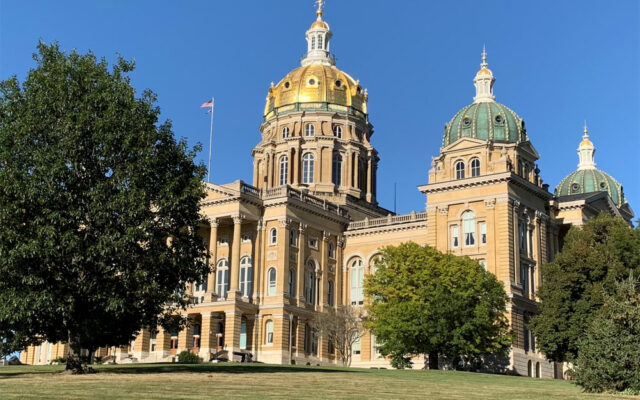Yard and Garden: Create Great Shade Gardens

 AMES, Iowa – Shade gardens are great places to be on hot summer days. Many plants are well-suited for shady gardens – and hostas aren’t the only options. Iowa State University Extension and Outreach horticulturists answer common questions about selecting the best plants to grow in the shade and the care recommendations you need to create great shade gardens.
AMES, Iowa – Shade gardens are great places to be on hot summer days. Many plants are well-suited for shady gardens – and hostas aren’t the only options. Iowa State University Extension and Outreach horticulturists answer common questions about selecting the best plants to grow in the shade and the care recommendations you need to create great shade gardens.
Which perennials grow well in shady locations?
Perennials are great choices for creating an attractive garden that comes back year after year. Be sure to select a variety of species that bloom at different times of the year to provide season-long color. Perennials that are good choices for partially to heavily shaded locations include black snakeroot (Actaea racemosa), red baneberry (Actaea rubra), lady’s mantle (Alchemilla mollis), astilbe (Astilbe spp.), Japanese painted fern (Athyrium niponicum var. pictum), heartleaf brunnera (Brunnera macrophylla), bleeding heart (Lamprocapnos spectabilis), Japanese forest grass (Hakonechloa macra), hosta (Hosta spp.), crested iris (Iris cristata), creeping phlox (Phlox stolonifera), Jacob’s ladder (Polemonium caeruleum), lungwort (Pulmonaria spp.), celandine poppy (Stylophorum diphyllum) and toad lily (Tricyrtis spp.).
What are some good native perennials for a shady site?
When selecting plants for the shade garden, one group of plants that is often overlooked are native woodland wildflowers. Since they are native to the state, woodland wildflowers are well adapted to the area. They are easy to grow and perform well when given a favorable environment.
Native woodland wildflowers that make good additions to the home landscape include wild columbine (Aquilegia canadensis), Jack-in-the-pulpit (Arisaema triphyllum), goat’s beard (Aruncus dioicus), Canadian wild ginger (Asarum canadense), Dutchman’s breeches (Dicentra cucullaria), shooting star (Dodecatheon meadia), false Solomon’s seal (Maianthemum racemosum), Virginia bluebells (Mertensia virginica), woodland phlox (Phlox divaricata), May apple (Podophyllum peltatum), Solomon’s seal (Polygonatum biflorum), bloodroot (Sanguinaria canadensis), trillium (Trillium spp.), merrybells (Uvularia grandiflora) and others.
Obtaining plants is easy. Woodland wildflowers are readily available at garden centers and mail-order nurseries. Do not remove plants from natural woodland areas.
Which native ferns are suitable for the home landscape?
Ferns are great additions to shade gardens and they pair nicely with woodland wildflowers and spring flowering bulbs. As these plants bloom early in the spring and often disappear by midsummer, they leave empty spaces for ferns to expand into during the summer months. Ferns are often fine-textured perennials that also combine nicely with other more coarse-leaved plants like hosta. Most ferns perform best in moist soils in partial to heavy shade
Iowa native ferns that are good additions to shady locations in the home landscape include lady fern (Athyrium filix-femina), sensitive fern (Onoclea sensibilis), ostrich fern (Matteuccia struthiopteris), cinnamon fern (Osmunda cinnamomeum), Christmas fern (Polystichum acrostichoides), interrupted fern (Osmunda claytoniana) and northern maidenhair fern (Adiantum pedatum).
What are some good annuals for shady garden areas?
Annuals are a great way to introduce color to a shade garden. Annuals that can be successfully grown in shady areas include wax begonia (Begonia × semperflorens-cultorum), impatiens (Impatiens walleriana), lobelia (Lobelia erinus), coleus (Solenostemon scutellarioides), wishbone flower (Torenia fournieri), polka dot plant (Hypoestes phyllostachya) and pansy (Viola × wittrockiana).
Which shrubs will grow in shade?
Shrubs are a great way to give height and structure to shade gardens since most perennials and annuals grown in shady locations tend to be shorter than 2 feet tall. Woody shrubs do best in partial shade locations that receive two to four hours of direct sun a day. Shrubs that can be successfully grown in partial shade include fothergilla (Fothergilla spp.), smooth hydrangea (Hydrangea arborescens), oakleaf hydrangea (Hydrangea quercifolia), Virginia sweetspire (Itea virginica), Japanese kerria (Kerria japonica), alpine currant (Ribes alpinum), arborvitae (Thuja spp.), hybrid yew (Taxus × media) and Russian cypress (Microbiota decussata).
Iowa native shrubs that can be successfully grown in partial shade include serviceberry (Amelanchier arborea), pagoda dogwood (Cornus alternifolia), gray dogwood (Cornus racemosa), bush honeysuckle (Diervilla lonicera), common witch hazel (Hamamelis virginiana), arrowwood viburnum (Viburnum dentatum), nannyberry (Viburnum lentago), American cranberrybush viburnum (Viburnum opulus var. americanum) and Canadian yew (Taxus canadensis).
What are the challenges for growing plants under shade trees?
Often the most prevailing challenge in shade gardens is the competition from trees. When gardening under trees, the soil can be quite dry, especially compared to the soil in shady areas created by buildings, fences or other structures. The roots of established trees compete with other plants for moisture and nutrients. This can limit their growth or require you to provide supplemental irrigation during dry periods. In addition, it can be difficult to plant around the tree roots. Often shifting the planting location a few inches allows you to plant without disturbing roots. Never sever tree roots to create a planting hole. If digging is too difficult or is causing damage to tree roots, consider growing shade plants in a container.



